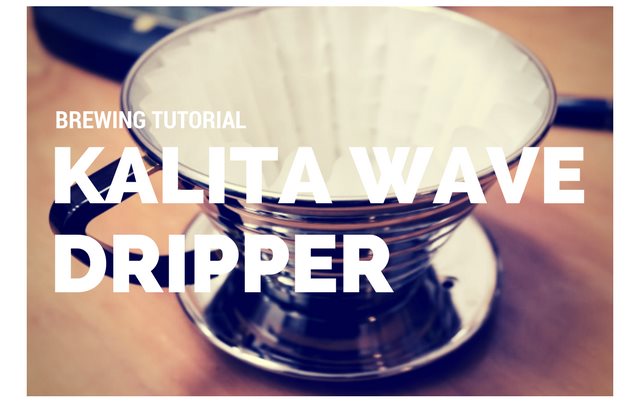
In 2013, I organized a trip for the Coffee Club of Seattle to visit the coffee scene of Olympia, Washington. While there, we visited two locations of Olympia Coffee Roasting, where they were making outstanding pour-over coffee using the Kalita Wave Dripper. This trip inspired me to get one for myself.

Kalita Wave brewing at Olympia Coffee Roasting
The Kalita Wave Dripper is a pour-over coffee brewer from Japan with a flat bottom design. The flat bottom design is for a more even extraction. Unlike the Bonavita Immersion Coffee Dripper or the Clever Coffee Dripper, the Kalita Wave is not a pour-and-wait, but a hands-on brewing method that requires an even flow of hot water on the grounds. So it resembles a Hario V60, but with a flat bottom filter.
The Kalita Wave Dripper comes in two sizes: #155 and #185. The #155 is smaller and ideal for a single-cup brewer, while the #185 is slightly larger. The Kalita Wave Dripper is available in glass or stainless steel, and the #185 is also available in ceramic.

Looking down into the stainless steel Kalita Wave Dripper, you will see three holes at the flat bottom where the coffee will exit.
The Kalita does not use a standard-size filter. Depending on which model you purchase, you will need to purchase custom Kalita Wave filters in either the #155 or #185.
Other items that are recommended:
- Glass server. You will be placing the brewer over something to catch the coffee. Kalita makes a 300 ml server for the #155 and a 500 ml for the #185. If you don’t use theirs, I’m sure you can find something in your kitchen that will work.
- Kitchen scale. We will be weighing both the coffee and the water. Brewing on a kitchen scale will make this process easier and more precise.
- Electric kettle, preferably with a narrow gooseneck pour spout for flow control. Kalita has their own model, but I prefer the Bonavita kettle because it controls water temperature.
- Timer.
Enough background. Let’s make some coffee!
#1 Add Filter
As stated above, the Kalita Wave Dripper requires its own brand of filters. Depending on your size, place the #155 or #185 filter in the brewer. Then, place the Dripper over the carafe you plan to brew the coffee into.
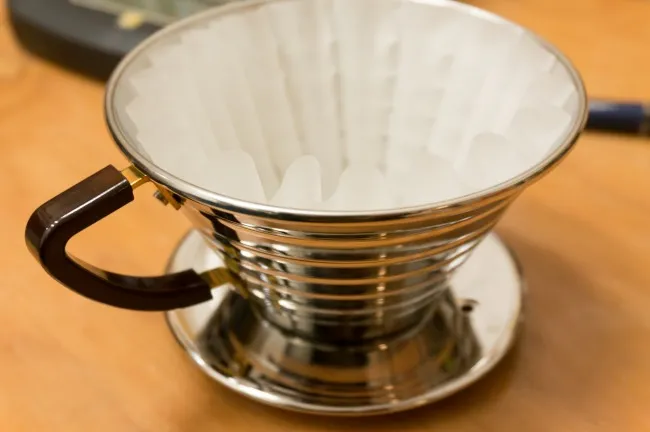
For the brewer, you will need either the Kalita #155 or Kalita #185 filter. Standard basket filters will not fit properly.
#2 Rinse Filter with Hot Water (optional)
As with most paper filter brewing methods, it is advised to rinse the paper filter. This will reduce any paper residue from getting in the coffee and help the filter cling to the brewer. With the Kalita, pour the water directly into the center and fill quickly. You do not want to pour along the sides, as you risk having the filter bend and lose its shape.
The added benefit of using hot water is that it will preheat the server. Once that is done, discard the water.
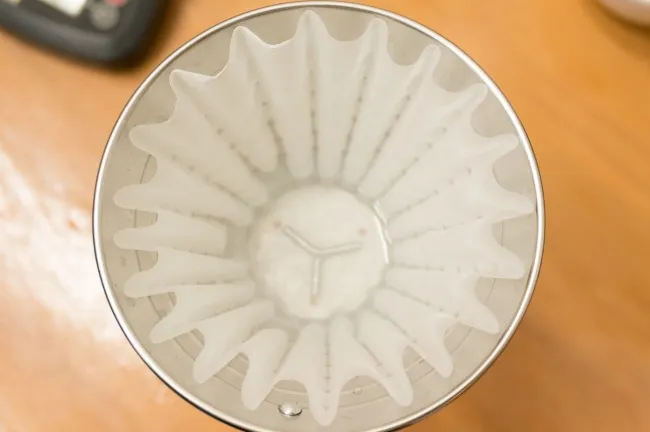
Rinse the coffee filter using hot water directly into the center, so the edges maintain their form.
However, you do not need to rinse the filter to get an excellent cup of coffee. Erin McCarthy won the 2013 World Brewers Cup with a Kalita Wave, but he did not rinse the filter. From his interview with Kirsten Stamn:
Don’t rinse the filter. Because the Wave’s filters are so thin, McCarthy says they won’t impart a papery taste to coffee if you skip the standard pre-brewing rinse.
Olympia Coffee Roasting’s instructional video also advises against rinsing. If you decide not to rinse the filter, using hot water to preheat the server is still good practice.
#3 Add Coffee
With most brewing methods, I like to start with a 17-to-1 brewing ratio. This means using 17 parts of water for every 1 part of coffee. We have two sizes of brewers. Here is a recipe to get you started for each one.
- #155 model: 300 grams (10.1 oz) water and 17-18 grams of coffee.
- #185 model: 500 grams (16.9 oz) water and 29-30 grams of coffee.
The coffee grind size will be between Medium and Medium Coarse. See our Coffee Grind Chart for a visual explanation.
The timer will confirm that you have an ideal grind size. The brew time to aim for is between 3:00 and 3:30. If it goes faster, tighten the grind a little. If it goes slower, adjust your grind to be coarser.
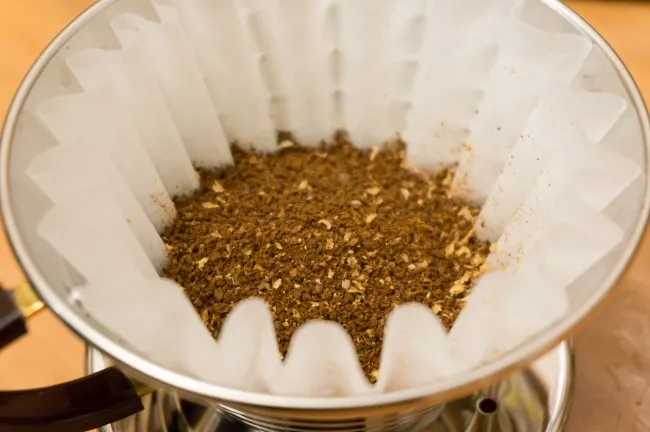
#4 Add Hot Water (Pulse or Continuous Pour)
This step in the brewing process will require the most focus. If you are using a scale, place the Kalita Wave Dripper with the ground coffee filter on top of the server and zero it out so it reads zero grams.
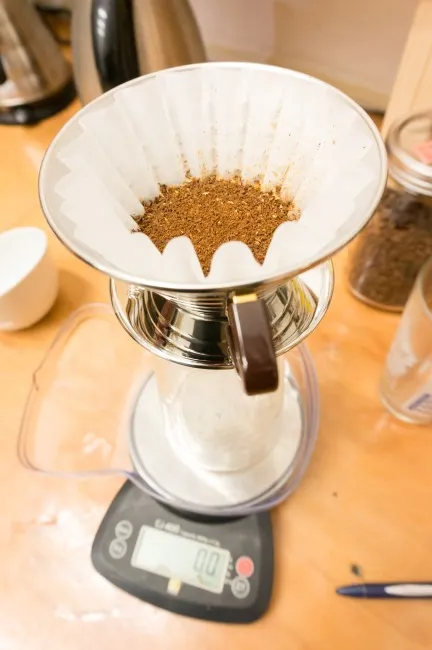
Zero out the scale before adding water.
There are two schools of thought when it comes to adding hot water. One is that your pour should be slow and steady throughout the brew. The other is the pulse method. This is when you pour, let the coffee pass through the grinds, and repeat during the brew cycle. Both methods work great, but I prefer the pulse method as it is easier.
The pulse method involves pouring a small amount of water initially over the grounds, allowing them to bloom. Then, pause, pour again, sometimes using a circular pattern.
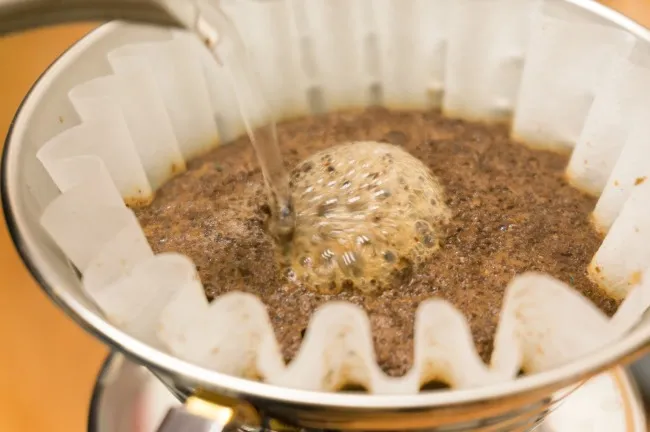
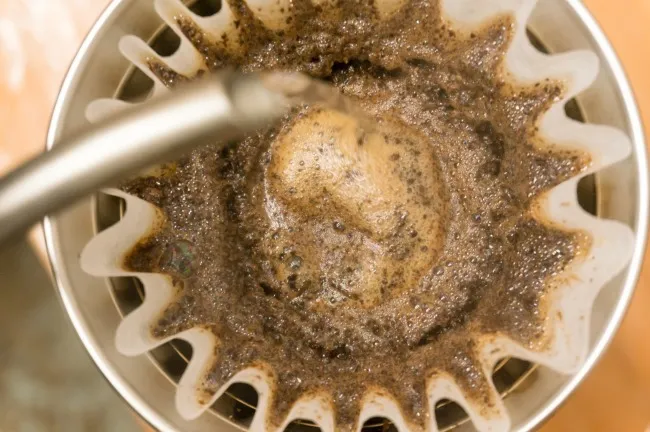
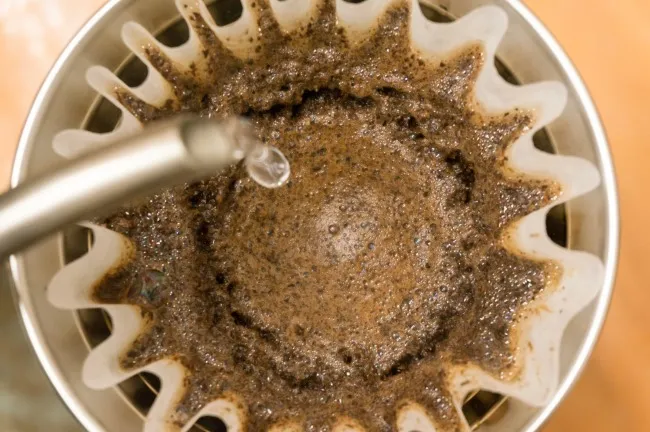
The most popular method is to pour until the coffee blooms and then use a circular motion for an even extraction. However, I have been served Kalita Wave coffee by a competition-level barista who poured it very slowly directly into the center with no circular motion, which was outstanding. His pouring technique was so gentle that it reminded me of an Olympic diver hitting the water without splashing.
Whichever method you use, do not stir the coffee.
#5 Serve
Remove the Kalita Wave Dripper, pour, and enjoy.
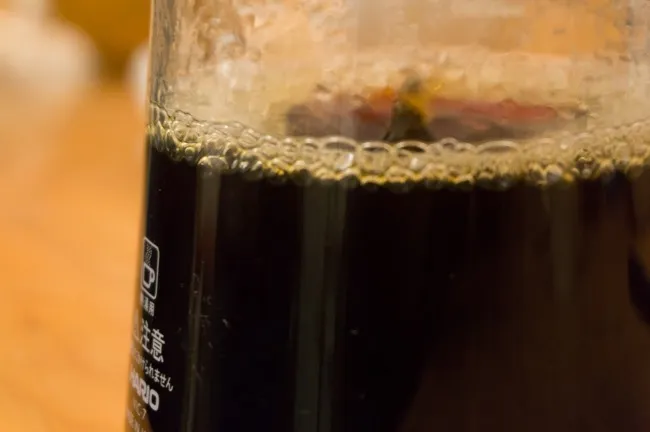
Last Words
You can still brew with the Kalita if you don’t have a kitchen scale or a fancy kettle. It will just take a little more practice.
The coffee scooper in canned coffee weighs about 10 grams. Although I have and use a kitchen scale, I often still use that little yellow scoop I saved from an old can of coffee I bought 20 years ago when I knew far less about coffee.
If you don’t have a gooseneck kettle, my advice is to go low and slow when you pour.
Resources
Pulse Method Pour Video – Kalita Wave video by Nicholas Cho showing a pulse method pour.
How to Brew Coffee with a Kalita Wave – Article by Kirsten Stamn. (2022: article no longer online)
*Brewing photos by Joseph Robertson of Extracted Magazine, a digital coffee magazine published for iOS and Android.
*